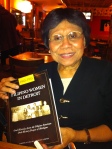YEA explores gentrification in Detroit during youth-led conversation in July
August 23, 2012
 DETROIT – Over
60 Detroit residents gathered in McCollester Hall of the Cass
Corridor Commons on July 12 for a special youth-led community
conversation on the subject of gentrification. The conversation was
hosted and facilitated by members of EMEAC's youth advocacy program,
the Young Educators Alliance (YEA), which is a part of EMEAC's policy
program StandUp!SpeakOut (SUSO)!
DETROIT – Over
60 Detroit residents gathered in McCollester Hall of the Cass
Corridor Commons on July 12 for a special youth-led community
conversation on the subject of gentrification. The conversation was
hosted and facilitated by members of EMEAC's youth advocacy program,
the Young Educators Alliance (YEA), which is a part of EMEAC's policy
program StandUp!SpeakOut (SUSO)!
“It is a powerful experience for adults to be led in an important
community conversation by teens and young adults,” said EMEAC Youth
Coordinator Will Copeland. “Sometimes it forces people to ask 'Why
aren't we talking about this more?' which is good for the resilience
of the community. YEA is going to continue to raise awareness about
gentrification through the rest of 2012. I hope that it goes beyond
this because the struggle for community self-determination is a
long term struggle.”
 | ||
| YEA Teamers Roger Boyd, Noelle Frye and Rayven Roberts |
“It was
interesting for YEA to share their perspectives as a youth
environmental justice group about the different experiences that are
common in Mid-Town itself,” said Ra. “That ties directly into
gentrification and that's the whole reason of us doing this
gentrification work period. YEA has been witnessing different things
and they are able to say, 'That is not right but that is not
uncommon.' We want to do something about it.”
Community members
shared a range of perspectives and opinions such as Andrew Newton of
Peoples Kitchen Detroit's in depth historical perspective as a
bi-racial youth growing up in the city while witnessing the current
changes, to Mt. Elliott Makerspace's Jeff Sturges who identified as a
gentrifier working out of the Church of the Messiah on Detroit's East
Side and Ms. Rekiba Brown of Occupy Detroit who spoke of biases against community residents in land use policies in the city.
“There was a
good mix of people in the room,” Ra said. “You had people coming
out and saying, 'Hey, I might be known as a gentrifier. Then you had
people from the community who were saying they've been affected by
gentrification and people moving into the city.
 “It was a good
for people to come together on both sides of the ball park to come
together and talk about how they felt about how the city was changing
and who will be affected by these changes and who will have access to
these new things and who will not.
“It was a good
for people to come together on both sides of the ball park to come
together and talk about how they felt about how the city was changing
and who will be affected by these changes and who will have access to
these new things and who will not.
“It was also
interesting hearing about the history. It was interesting hearing
people say, 'My family came from the south. We migrated here and the
reason why we came was because we weren't wanted down there. Now we
come here and it seems history is repeating itself.”
The July
conversation on gentrification was the third YEA has been involved
with. Ra represented EMEAC during a December gentrification
conversation sponsored by Model D. Copeland, Roberts, and former
EMEAC Associate Director Ahmina Maxey took part in a gentrification
discussion earlier this year at the Hush House Museum of Black
History with Hush House founder Charles Simmons and Zone 8 activist
Yusef Shakur.
Although
gentrification is a difficult subject to engage in public discourse,
YEA Team members plan to continue to explore the topic and advocate
for community voice.
“Gentrification
is such a touchy subject. It's like talking about religion,” Ra
said. “It was interesting too see people step out of their comfort
zone, which was a challenge. YEA had to step up and bring this to the
space because few of our community leaders or allies were available,
and they did it.”
Copeland agreed
and said YEA plans similar events going forward by going into
neighborhoods and gathering more perspectives from native Detroiters.
“In the fall we
will raise the question 'How is gentrification an environmental
injustice?' YEA participated in the Building Movement conference
which looked at land use in the city of Detroit, absentee and
out-of-state landowners, and mapping for community power. (EMEAC
Executive Director) Diana (Copeland) is very passionate about
challenging slumlords so this is something we can incorporate in our
work. We can draw connections between the residential land grabs
taking place in the neighborhoods and the gentrification taking place
in the business and entertainment districts.
“Lastly YEA is working with ReMedia to make a media project on gentrification. We have completed some interviews with community members and are compiling other footage. This project has a lot of potential to create a bold, new statement that is very appropriate for our times.”








